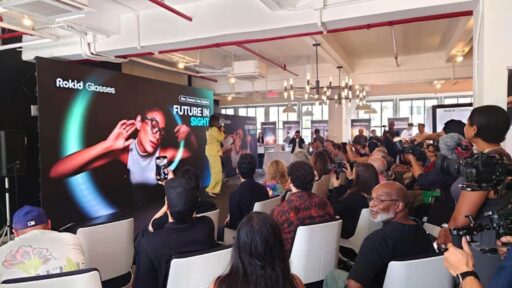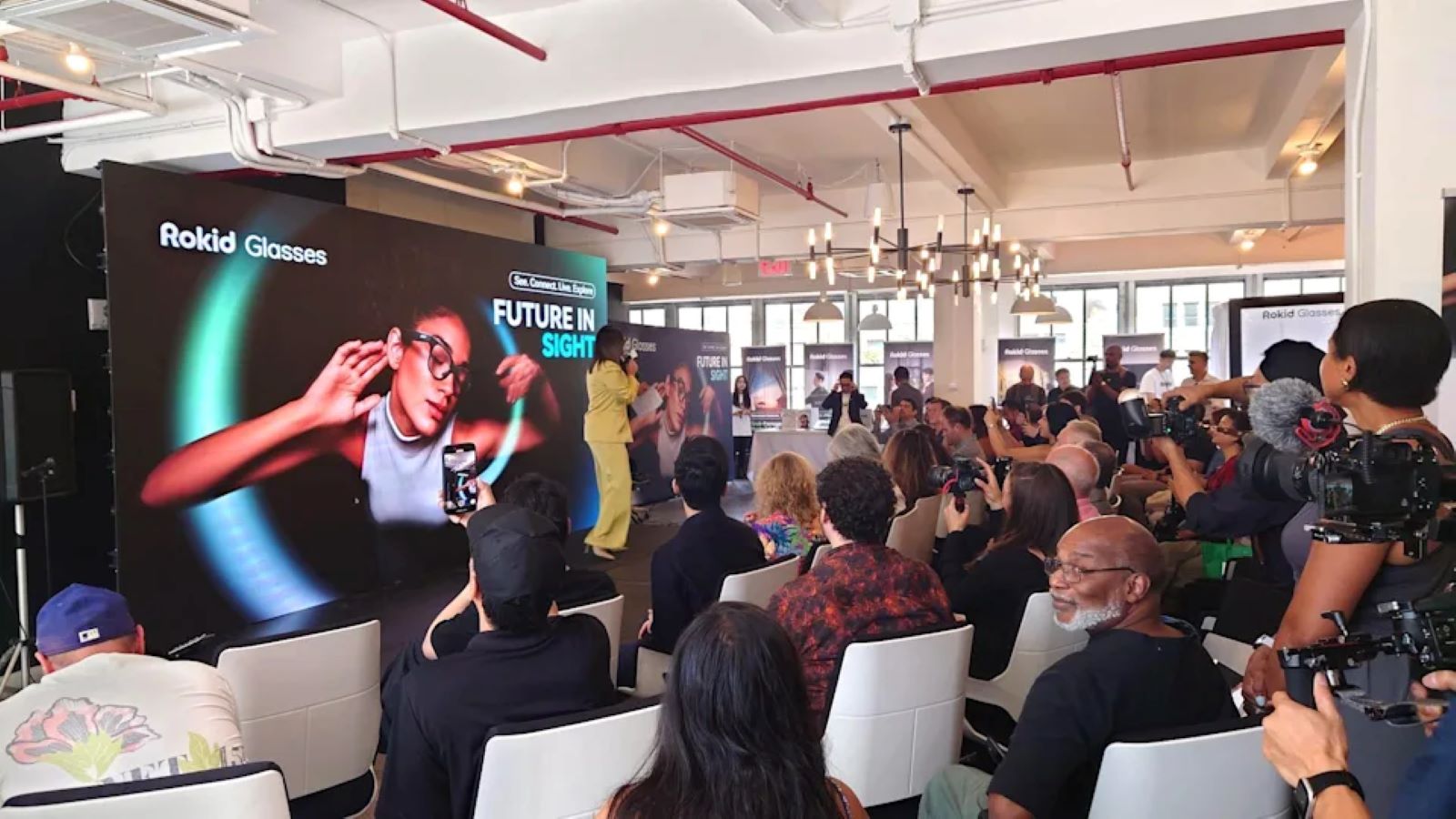Rokid, best known for its augmented reality (AR) technology, has just unveiled its newest product in New York City: the Rokid Glasses. The launch event, called “Future in Sight,” was centered on the company’s vision for wearable AI. At only 49 grams, the glasses are light enough to feel like everyday eyewear, but they are filled with AR visuals and AI-powered features designed for both consumers and professionals.
Key Takeaways
• Rokid Glasses are lightweight AI and AR smart glasses, weighing just 49 grams.
• They feature a built-in 12-megapixel camera and a binocular monochrome display.
• The glasses run on the Qualcomm AR1 platform.
• Core functions include real-time translation, live transcription, navigation, and object recognition.
• Now available for early supporters on Kickstarter.
For a long time, Rokid’s main focus was enterprise solutions, such as remote assistance in logistics or specialized uses in healthcare and manufacturing. Their previous model, the Rokid Glass 2, was a monocular headset built for that type of environment. The new Rokid Glasses move in a different direction. They are designed to look and feel more like regular eyewear, which makes them suitable for everyday consumer use while still offering professional applications.
The glasses use a binocular monochrome display supported by a waveguide optical system. This setup projects a heads-up display directly into the user’s view. It can show turn-by-turn navigation, act as a teleprompter, or provide real-time translated text. The approach differs from other smart glasses like Ray-Ban Meta glasses, which are more audio-focused and emphasize subtlety.
Artificial intelligence is at the center of the Rokid Glasses. The system processes input from the built-in camera and microphones, then delivers useful data to the wearer. The AI enables real-time translation across 89 languages and supports live transcription. The 12-megapixel first-person camera is not just for capturing photos and videos. It also powers computer vision tasks, such as recognizing objects and offering context-aware information in real time.
Other companies are active in this space as well. Xreal and Viture, for instance, produce AR glasses designed mainly for gaming or for creating virtual displays. Rokid’s strategy sets its product apart by positioning it as a more complete daily tool that combines AI with AR.
The New York launch event included a panel discussion on the future of wearable AI. Experts shared their views on how technology might evolve from smartphones to more personal wearable devices. There was also a podcast session titled “AI Glasses For Social Good” featuring CaringKind, a New York City organization that supports Alzheimer’s and dementia caregivers. This conversation explored the potential for AI glasses to provide accessibility features and memory support, showing how the technology could reach beyond entertainment or productivity.
Following the public unveiling, the Rokid Glasses became available to early backers on Kickstarter. Rokid has an established developer community with over 200 academic and industry projects already using its SDK and cloud platform. This network is expected to contribute new applications for the glasses. The company also announced a “Dream Journey” world tour to introduce the product worldwide.
On Kickstarter, the glasses are priced at an early bird rate of $479, which is 20 percent lower than the planned retail price of $599. Rokid expects to begin shipping in November 2025, giving early adopters the chance to be among the first to experience its vision for consumer AI wearables.
Related FAQs
Q. What is the main difference between Rokid Max and the new Rokid Glasses?
A. The Rokid Max is an AR device primarily for personal media consumption, like watching movies or playing games on a large virtual screen. The new Rokid Glasses are designed for daily use and feature AI functions like real-time translation, navigation, and object recognition. They have a different form factor and a focus on AI productivity tools.
Q. Are Rokid Glasses a full augmented reality headset?
A. The Rokid Glasses are generally considered AI glasses with augmented reality features. They project a heads-up display for data and simple graphics. They do not create fully immersive 3D digital objects that interact with the real world in the same way as more advanced, and often bulkier, AR headsets.
Q. What can you do with the Rokid Glasses?
A. You can use them for real-time multilingual translation, live transcription during conversations, getting navigation directions, and using a teleprompter. They can also take photos and videos with a built-in camera and provide notifications.
Q. How long does the battery last on Rokid Glasses?
A. The glasses have a 210mAh internal battery, which the company states provides 8-10 hours of mixed use. This can go down to 45 minutes for intensive video recording. Some tiers on the Kickstarter campaign include an external 3,000mAh charging case.





